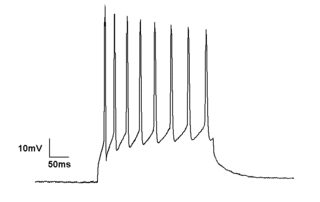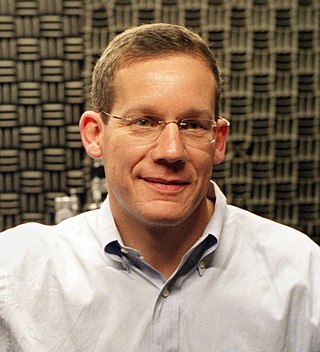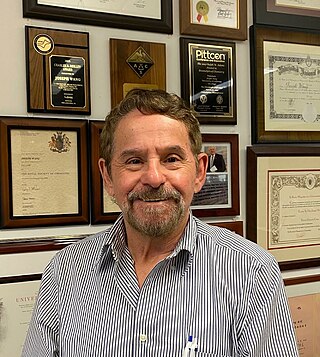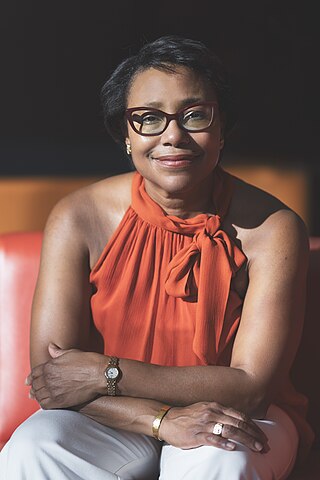Bianxiao Cui | |
|---|---|
| Born | Henan, China |
| Nationality | American |
| Alma mater | |
| Scientific career | |
| Institutions | |
Bianxiao Cui is the current Job and Gertrud Tamaki Professor of Chemistry and a fellow of the Stanford Neuroscience Institute at Stanford University. [1]
Bianxiao Cui | |
|---|---|
| Born | Henan, China |
| Nationality | American |
| Alma mater | |
| Scientific career | |
| Institutions | |
Bianxiao Cui is the current Job and Gertrud Tamaki Professor of Chemistry and a fellow of the Stanford Neuroscience Institute at Stanford University. [1]
Bianxiao Cui graduated from University of Science and Technology of China in 1998 with a bachelor's degree in material science. [2] She received her Ph.D. in 2002 from the University of Chicago under Stuart Rice in physical chemistry. [3] [4] Between 2002 and 2007, she was a postdoctoral associate with Steven Chu at Stanford University. [5] In 2008, she was appointed as the assistant professor in chemistry with Stanford University, followed by promotion to associated professorship with tenure in 2015, full professorship in 2018, and Job and Gertrud Tamaki Professor of Chemistry in 2020. She is a current member of the Bio-X Scientific Leadership Council.
The Bianxiao Cui lab develops new tools to advance understandings of signal transduction in the complicated environment of living cells with tools drawn from chemistry, materials science, engineering, and molecular biology. Her research is focused on four major directions: (1) Nano-bio interface: membrane curvature [6] and intracellular signaling; [7] [8] [9] [10] (2) Bioelectronics: nanoscale electrodes for intracellular electrophysiology; [9] (3) Optical Electrophysiology using electrochromic materials; and (4) Optical control of protein functions in neurons. The lab has special interest in membrane curvature, nano-bio interface, bioelectronics, and neurobiology.
Her awards and distinctions include the Packard Fellowships in Science and Engineering, [11] Searle Scholar Award, [12] Barany Award from Biophysical Society, [13] [14] NIH New Innovator Award, [15] [16] and NSF CAREER Award. [17]

Electrophysiology is the branch of physiology that studies the electrical properties of biological cells and tissues. It involves measurements of voltage changes or electric current or manipulations on a wide variety of scales from single ion channel proteins to whole organs like the heart. In neuroscience, it includes measurements of the electrical activity of neurons, and, in particular, action potential activity. Recordings of large-scale electric signals from the nervous system, such as electroencephalography, may also be referred to as electrophysiological recordings. They are useful for electrodiagnosis and monitoring.

Charles M. Lieber is an American chemist, inventor, nanotechnologist, and writer. In 2011, Lieber was named the leading chemist in the world for the decade 2000–2010 by Thomson Reuters, based on the impact of his scientific publications. He is known for his contributions to the synthesis, assembly and characterization of nanoscale materials and nanodevices, the application of nanoelectronic devices in biology, and as a mentor to numerous leaders in nanoscience.

Joseph Wang is an American biomedical engineer and inventor. He is a Distinguished Professor, SAIC Endowed Chair, and former Chair of the Department of Nanoengineering at the University of California, San Diego, who specialized in nanomachines, biosensors, nano-bioelectronics, wearable devices, and electrochemistry. He is also the Director of the UCSD Center of Wearable Sensors and co-director of the UCSD Center of Mobile Health Systems and Applications (CMSA).
Bioelectronics is a field of research in the convergence of biology and electronics.

Anthony "Tony" Guiseppi-Elie is a Trinidad-born, American scientist, engineer, entrepreneur, and avid Wikipedia editor. He is the President and Sr. Fellow of the American International Institute of Medical Sciences, Engineering and Innovation and the President and Scientific director of ABTECH Scientific, Inc. He is noted for his research and commercial development of biologically inspired and chemically responsive electroconductive hydrogels. Guiseppi-Elie is the Founding Editor-in-Chief of the transdisciplinary journal Bioengineering.
Hongkun Park is Mark Hyman Jr. Professor of Chemistry and Professor of Physics at Harvard University. He received his BS in chemistry at Seoul National University in 1990, and his PhD in physical chemistry at Stanford University in 1996 under Richard Zare. From 1996 to 1999 he was a postdoctoral fellow at Lawrence Berkeley National Laboratory under A. Paul Alivisatos and Paul McEuen.

Zhenan Bao is a Chinese-born American chemical engineer. She serves as K. K. Lee Professor of Chemical Engineering at Stanford University, with courtesy appointments in Chemistry and Material Science and Engineering. She served as the Department Chair of Chemical Engineering from 2018 to 2022. Bao is known for her work on organic field-effect transistors and organic semiconductors, for applications including flexible electronics and electronic skin.

Paula Therese Hammond is an Institute Professor and the Vice Provost for Faculty at the Massachusetts Institute of Technology (MIT). She was the first woman and person of color appointed as head of the Chemical Engineering department. Her laboratory designs polymers and nanoparticles for drug delivery and energy-related applications including batteries and fuel cells.
Alan T. Charlie Johnson is an American physicist and a professor in physics and astronomy at the University of Pennsylvania. Johnson currently serves as the founding executive editor of the scientific journal AIP Advances and the co-founder of Graphene Frontiers, LLC.
Tan Weihong is a Chinese chemist. He is the University of Florida Distinguished Professor, V. T. and Louise Jackson Professor of Chemistry at the University of Florida, and also the Professor of Chemistry and Chemical Engineering, Professor of Biology, and Director of the State Key Laboratory of Chemo/Biosensing and Chemometrics at Hunan University in China. He was elected an academician of the Chinese Academy of Sciences in 2015 and The World Academy of Sciences in 2016.

Sergiu P. Pașca is a Romanian-American scientist and physician at Stanford University in California. He is renowned for his groundbreaking work creating and developing stem cell-based models of the human brain to gain insights into neuropsychiatric disease. His lab was the first to develop and name assembloids: multi-unit self-organizing structures created in 3D cultures that allow for the study of human neural circuit and systems functions in vitro. Pașca’s lab generated and published human cortico-striatal and cortico-motor assembloids in 2020. Combining regionalized neural organoids pioneered in the lab and studies with human forebrain assembloids and transplantation, in 2024, Pașca developed a therapeutic for a severe genetic disorder called Timothy Syndrome, which was published on the cover of Nature.
Gurpreet Singh is a professor of Mechanical and Nuclear Engineering at [Kansas State University]. He is endowed by the Harold O. and Jane C. Massey Neff Professorship in Mechanical Engineering. Singh was born in Ludhiana, India; he currently resides in the United States.
Shanhui Fan is a Chinese-born American electrical engineer and physicist, with a focus on theoretical, computational and numerical aspects of photonics and electromagnetism. He is a professor of electrical engineering, and a professor of applied physics at Stanford University. He is the director of the Edward L. Ginzton Lab and Senior Fellow at the Precourt Institute for Energy.

Yi Cui is a Chinese-American scientist specializing in the fields of nanotechnology, materials science, sustainable energy, and chemistry. Cui is Fortinet Founders Professor at Stanford University, where he also serves as a professor of materials science and engineering and of energy science and engineering. He is a Highly Cited Researcher in the fields of materials science, environment and ecology, engineering, and chemistry as of 2023. From 2020 to 2023, Cui was the director of the Precourt Institute for Energy, and since 2023 he has served as the inaugural faculty director of the Sustainability Accelerator in the Doerr School of Sustainability.
Yayuan Liu is a Chinese-American materials scientist at the Massachusetts Institute of Technology. Her research considers electrochemistry, nanomaterials, and materials characterisation for the development of next-generation batteries. She was selected as one of the 2019 American Chemical Society Young Investigators and included in the 2021 Forbes 30 Under 30 list of top scientists.
Lynette Cegelski is an American physical chemist and chemical biologist who studies extracellular structures such as biofilms and membrane proteins. She is an associate professor of chemistry and, by courtesy, of chemical engineering at Stanford University. She is a Stanford Bio-X and Stanford ChEM-H affiliated faculty member.
Julie Suzanne Biteen is a Canadian-born American chemist who is professor of chemistry and biophysics at the University of Michigan. Her research considers the development of imaging systems for biological systems. She was named the Stanford University Sessler Distinguished Alumni Lecturer in 2021.

Wei Gao is a Chinese-American biomedical engineer who currently serves as a professor of medical engineering at the California Institute of Technology (Caltech). Gao has been a professor at Caltech since 2017 and is an associate editor of the journals Science Advances, Biosensors and Bioelectronics, npj Flexible Electronics (Nature), Journal on Flexible Electronics (IEEE), and Sensors & Diagnosis.
Charles Wyatt Shields IV is an American biomedical engineer and assistant professor at the University of Colorado Boulder in the Department of Chemical and Biological Engineering. His research involves the rational design of colloidal and supracolloidal particles for applications in drug delivery and biosensing.

Duygu Kuzum is a Turkish-American electrical engineer who is a professor at the University of California, San Diego's Jacobs School of Engineering. She develops transparent neural sensors based on single-layer materials. She was awarded a National Institutes of Health New Innovator Award in 2020.